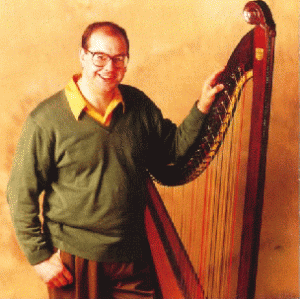 The world’s foremost player of the Welsh Triple Harp, Robin Huw Bowen, is also a campaigner for its revival. Outside of Wales pedal harps have replaced the triple harp. Robin’s style reflects the carefree Welsh gypsy harpists of the last century. His irreverent yet sensitive arrangements take the triple harp out of the parlor and into the concert hall for a bit of fun.
The world’s foremost player of the Welsh Triple Harp, Robin Huw Bowen, is also a campaigner for its revival. Outside of Wales pedal harps have replaced the triple harp. Robin’s style reflects the carefree Welsh gypsy harpists of the last century. His irreverent yet sensitive arrangements take the triple harp out of the parlor and into the concert hall for a bit of fun.
Born in Liverpool to Welsh-speaking parents, Robin learned the simple Celtic harp while in school. He was first exposed to the triple harp by the brothers Dafydd and Gwyndaf Roberts, who played the instrument with the traditional Welsh group Ar Log.
Robin earned a degree in Welsh language and literature from the University of Aberystwyth, Mid-Wales. While employed by the National Library of Wales, he researched the music and techniques of the old Welsh harpers through manuscripts and publications. When not touring, Robin continues his research into the Welsh harp tradition. In 1990, he set up Gwasg Tiers, his own press, to publish books of Welsh tradition.
He has performed extensively around the world, with the Welsh folk group Mabsant, and since 1989 as a solo performer, and with the group Cusan Tan, and has recorded six albums.
Visit Robin Huw Bowen’s Website
_______________________________________________
About the Welsh triple harp:
The triple harp is now unique to Wales, and is known as the “Welsh harp,” but it did not originate there. Its origins are obscure, but it probably came from Europe in the 18th century. The triple harp was popular for a time all over Europe, being used for both art music and folk music, but after the pedal harp was invented, the triple harp and its awkward cousin, the chromatic harp, both fell out of use. For some reason, the Welsh people, perhaps enjoying being different (in harps as well as language), adopted the triple harp as uniquely theirs. The triple harp is very difficult to play, so even among the Welsh it has mostly been abandoned in favor of the pedal harp. For the Welsh people, however, the triple harp represents an unbroken tradition, passed on by descendents of gypsy harp players from the Victorian age.
The triple harp is strung with three rows of gut strings, for a total of 89 strings. The outer rows are strung in unison with each other, and the middle row is tuned to the accidentals (sharps and flats). The strings are played using the pads of the fingers, not fingernails as with some harps. The unison strings can be played in several different ways: melody in one hand, in both hands in unison, alternating melody in both hands, or melody in one hand and harmony in the other like a keyboard. Only on the Welsh triple harp can the harpist play quick repeated notes by alternating unison strings. Playing repeated notes quickly on a single-strung harp is impossible because it stops the strings from vibrating.
The pedals on a pedal harp are used for changing the accidentals. On a triple harp, the chromatic strings run between the outer rows of strings. To play a sharp or a flat, the harpist has to reach inside the outer rows to pluck the inner string. It is an amazing feat of coordination! The simpler Celtic harp is single-strung and varies from lap-size to about five feet tall, whereas the Welsh triple harp is about six feet tall. It is bigger and heavier than the Celtic harp, but cheaper and much lighter than the pedal harp. The triple harp has a distinctive back curlicue at the top of the harp, and is played resting on the opposite shoulder than other harps.
